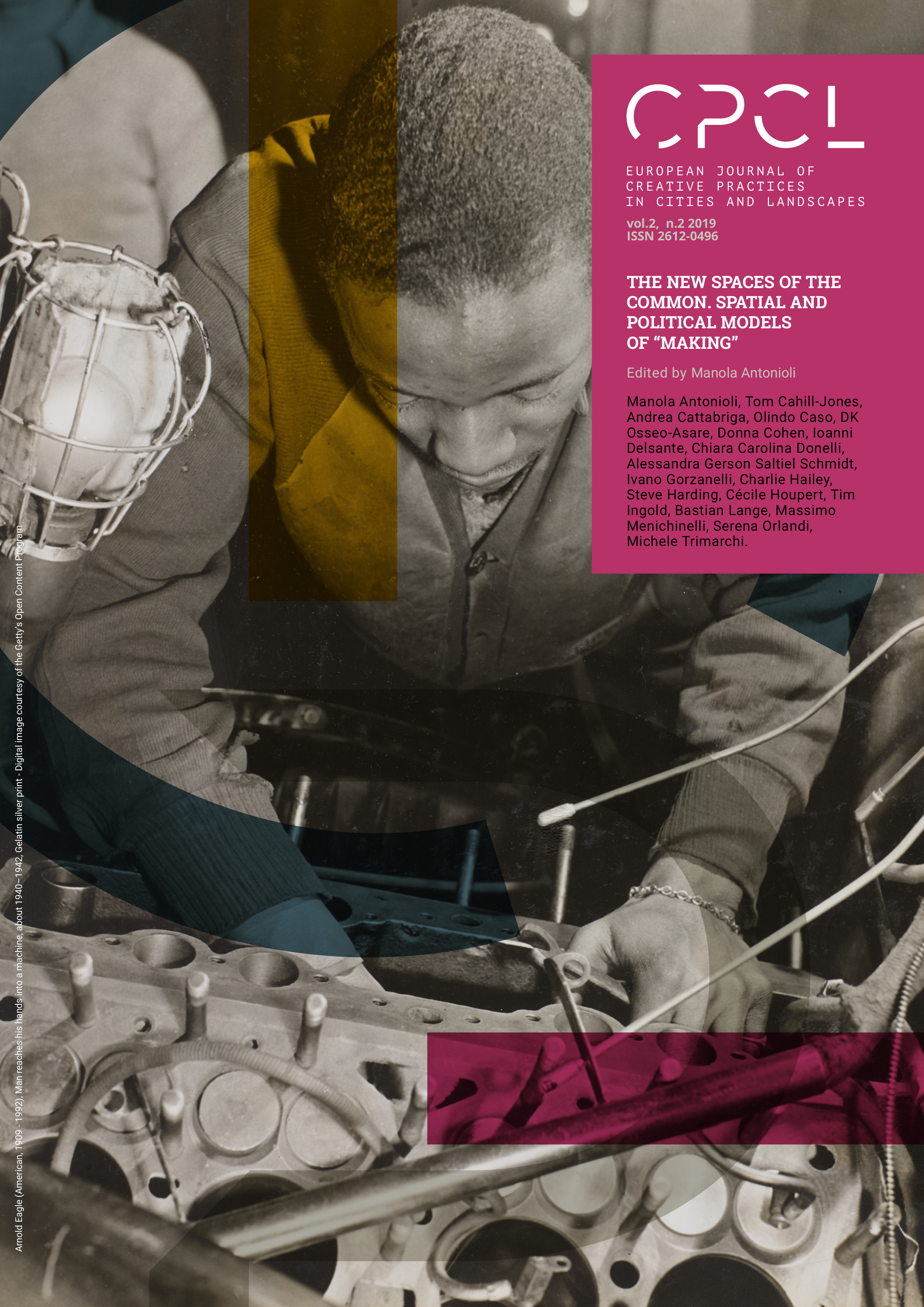Mapping Uses, People and Places: Towards a Counter-Cartography of Commoning Practices and Spaces for Commons. A Case Study in Pavia, Italy
DOI:
https://doi.org/10.6092/issn.2612-0496/9768Keywords:
third spaces, urban commons, commoning practices, critical mapping, counter cartographyAbstract
The agency of mapping has been an increasingly relevant area of enquiry in architecture, urbanism and landscape at the very least since James Corner published his seminal paper on the agency of mapping in 1999. A few projects aiming to map the commons in cities have since developed, providing critical or counter-cartographies in which information on local groups and communities, activities and other informal evidence is collated.
This paper draws on the concept of urban commons as third places in the sense of being beyond market or state control and management, on the notion that commons cannot exist without commoning practices and on the idea of common spaces as distinct from public, private or communal ones. As such, urban commons should be mapped not as static or invariable but rather as dynamic entities that evolve over time. From that perspective, the agency of mapping should take into consideration both current commoning practices and places suitable for these agencies to happen. Spatial features and architectural configurations may also play a role in calling for, or hosting, those agencies.
This paper proposes a methodology based on both primary and secondary data collection. The former is based on a variety of methods and tactics including psycho-geographical tours, non-interactive and interactive forms of observations and mapping. The process of mapping aims to showcase both what is already taking place and possibilities for future uses as a "hidden potential." The findings include the identification of specific places where several layers converge. These may become case studies that can be further investigated through methods such as research by design and community engagement.
References
Atelier Città, ‘Ex-Vuoto Pavia’ https://ateliercitta.com/ex-vuoto-pavia/
Belingardi, Chiara F. M. Comunanze urbane. Autogestione e cura dei luoghi. Firenze: Firenze University Press, 2015.
Bertolino, Nadia and Costa-Santos, Sandra. “Towards a definition of ‘place’. Cross-disciplinary methodology for integrating architectural and sociological data in Claremont Court, Edinburgh.” Paper presented at A Panel on Inter and Transdisciplinary Relationships in Architecture, Athens, Greece, 3-6 July 2017.
Bertolino, Nadia, Delsante, Ioanni and Haddadian Shirin, “Consciously uncontrolled: a psychogeographic approach to urban mapping”. In: Mapping urban changes. Zagreb: Institute of Art History - Zagreb, 2017.
Dèbord, Guy. (1956) Theory of the Dérive. Les Lèvres Nues #9. Paris, 1956.
Dellenbaugh, Mary, Kip, Marcus, Bieniok, Majken, Müller, Agnes Katharina and Schwegmann, Martin. Urban Commons. Moving beyond State and Market. Basel: Birkhauser, 2015.
Delsante, Ioanni. “Quale progetto per quale ‘città’?”, in Stendardo, Luigi. Forme della città contemporanea. Frammenti di visioni urbane. (Melfi: Libria, 2017)
Delsante, Ioanni. “Arcipelaghi urbani”, in Stendardo, Luigi. Forme della città contemporanea. Frammenti di visioni urbane. (Melfi: Libria, 2017)
Delsante, Ioanni and Bertolino, Nadia. “Urban spaces’ commoning and its impact on planning. A case study of the former slaughterhouse exchange building in Milan.” Der öffentliche Sektor - The Public Sector, no.43 (1) (2017).
Delsante, Ioanni and Bertolino, Nadia. “Social movements and the co-production of the urban space. A case study of activists-led spatial production and citizens’ participation in East Milan”, Journal of Peer Production, 11 (01) (2018).
Delsante, Ioanni and Miron, Luciana I.G. “Urban growth, regeneration and social inclusion in Porto Alegre: the City Entrance integrated programme case study”. Journal of Urban Planning, Landscape and Environmental Design, 2(2) (2017): 239-254
De Soto, Pablo, Delinikolas, Demitri, Dragona, Daphne, Senel, Asilhan and Pérez de Lama, Josè. “Mapping the Urban Commons: a Parametrical and Audiovisual Method”. V!RUS, issue 11, (2015)
Downs, Roger M. and Stea, David. Maps in Minds: Reflections on Cognitive Mapping. New York: Harper & Row, 1977.
Foster, Sheila and Iaione, Christian, The City as a Commons. 34 Yale L. & Pol'y Rev. 281 (2016).
Hertzberger, Herman. Lessons for students in architecture. Rotterdam: Uitgeverij 010 Publishers, 1991.
Krier, Rob. Stadtraum = Urban space. Solingen: Umbau-Verl., 2009.
Lynch, Kevin. The image of the city. Cambridge, Massachusetts: The MIT Press, 2012.
Marti Aris, Carlos. Le variazioni dell'identità Il tipo in architettura. Milano: Clup, 1991
Oldenburg, Ray. The Great Good Place: Cafes, Coffee Shops, Community Centers, Beauty Parlors, General Stores, Bars, Hangouts, and How They Get You Through the Day. New York: Paragon House, 1989.
Ostrom, Elinor. Governing the Commons: The Evolution of Institutions for Collective Action. Cambridge [England]; New York: Cambridge University Press, 1990.
Stavrides, Stavros. Towards the City of Thresholds. Trento: Professionaldreamers, 2010.
Stavrides, Stavros. Common Space. The city as Commons. London: Zed Books, 2016.
Temporiuso, ‘Mapping the urban voids’ http://www.temporiuso.org/?page_id=8
Published
How to Cite
Issue
Section
License
Copyright (c) 2019 Ioanni Delsante, Serena Orlandi
Copyrights and publishing rights of all the texts on this journal belong to the respective authors without restrictions.This journal is licensed under a Creative Commons Attribution 4.0 International License (full legal code).
See also our Open Access Policy.





